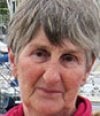John McCann is a well-known farmer in Whiterock, on the west shore of Strangford Lough in County Down, and his late father, Thomas McCann farmed the land on which Strangford Lough Yacht Club now stands. John has a vision of how he would like to move forward into the future. He is writing a book on the traditional farming methods in the Lough, and on the two islands he owns, Trasnagh and Calf, covering an environmental study from the receding last ice age to today’s ecosystem.
He goes on “ I am forming a group called ‘Friends of Trasnagh’ and I would welcome input from people with specific knowledge of island fauna, geology, archaeology, ancient farming, the famine, birds, insects, general wildlife, intertidal animals and plants, shellfish above and below low tide, seashore mammals, lichens, migratory and resident birds”.
Originally Trasnagh and Calf were farmed by a resident family. In the mid-1800s the potato famine devastated the Irish population and many of the inhabitants of the islands either died or emigrated, in the case of Trasnagh to New Zealand.
From around the 1870s the island farms were bought or rented to other local farmers. Trasnagh had an extensive range of buildings with pig sty’s, barns, stock house, deep well which was built from the 1600s. Cattle and sheep were transported by a 27 ft four oar open boat, with four cows at a time swimming alongside the boat or 20 sheep inside it.
John says “ The last time this was done I was about 7 years old. I do remember the four oarsmen and the cattle. It was a dangerous operation no rescue boats no outboard motors”.
Since the old farm was built, storms and age had depleted some of the buildings and during the Troubles, the walls were damaged searching for shipments of suspected arms coming into the Lough. Without the resident farmer maintenance was harder; however, it was still used extensively for the sheep management bringing them into the barn for dosing and sheering.
As reported in afloat.ie on 19th January, John wanted to try to restore the 30-acre working farmstead to full active livestock farming and helped by the National Trust barge, livestock movement was much easier. In addition to the 50 sheep there now, a small heard of Scottish Highland cattle were added since completion of the hay storage barns and buildings. The residents now include 10 Highland cattle, 50 ewes, four Suffolk ewes with baby lambs, and the two old goats.
John’s aim is to gather more knowledge about the islands. “I will take members of our group of like-minded people to and from the island. Our aim is to highlight scientific information and find out as much as possible of the wildlife, soil, and climate and gain new knowledge where possible. The range of skills needed is immense. All farming practices will be environmentally managed to make these two islands a source of information and study of how to protect them and to bring a knowledge of the biodiversity.
More information from [email protected]



























































